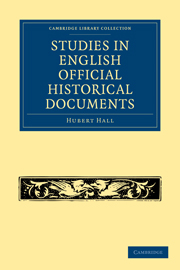Book contents
- Frontmatter
- PREFACE
- Contents
- ERRATA
- PART I THE SOURCES OF OFFICIAL HISTORICAL DOCUMENTS
- PART II THE DIPLOMATIC OF OFFICIAL HISTORICAL DOCUMENTS
- INTRODUCTION TO THE DIPLOMATIC STUDY OF OFFICIAL DOCUMENTS
- THE ANGLO-SAXON CHARTERS
- ANGLO-NORMAN CHARTERS AND WRITS
- LATER CHARTERS AND DIPLOMATIC INSTRUMENTS
- LETTERS, STATE PAPERS AND DEPARTMENTAL INSTRUMENTS
- ROYAL SURVEYS, INQUISITIONS AND ASSESSMENTS
- ROYAL ACCOUNTS
- JUDICIAL PROCEEDINGS
- APPENDIX I A Classified Table of Diplomatic Instruments
- APPENDIX II Early Diplomatic Criticism
- APPENDIX III The Charters of King Athelstan (Concordance of Formulas)
- APPENDIX IV Table showing the Relationship of the Pre-Conquest and Post-Conquest Diplomata
- APPENDIX V Documents connected with the Issue of the Great Seal (1662)
- APPENDIX VI Fees of the Seal
- APPENDIX VII Note on the Bibliography of English Diplomatic
- PART III THE PALAEOGRAPHY OF OFFICIAL DOCUMENTS
- TABLE OF MATTERS
LATER CHARTERS AND DIPLOMATIC INSTRUMENTS
Published online by Cambridge University Press: 07 September 2010
- Frontmatter
- PREFACE
- Contents
- ERRATA
- PART I THE SOURCES OF OFFICIAL HISTORICAL DOCUMENTS
- PART II THE DIPLOMATIC OF OFFICIAL HISTORICAL DOCUMENTS
- INTRODUCTION TO THE DIPLOMATIC STUDY OF OFFICIAL DOCUMENTS
- THE ANGLO-SAXON CHARTERS
- ANGLO-NORMAN CHARTERS AND WRITS
- LATER CHARTERS AND DIPLOMATIC INSTRUMENTS
- LETTERS, STATE PAPERS AND DEPARTMENTAL INSTRUMENTS
- ROYAL SURVEYS, INQUISITIONS AND ASSESSMENTS
- ROYAL ACCOUNTS
- JUDICIAL PROCEEDINGS
- APPENDIX I A Classified Table of Diplomatic Instruments
- APPENDIX II Early Diplomatic Criticism
- APPENDIX III The Charters of King Athelstan (Concordance of Formulas)
- APPENDIX IV Table showing the Relationship of the Pre-Conquest and Post-Conquest Diplomata
- APPENDIX V Documents connected with the Issue of the Great Seal (1662)
- APPENDIX VI Fees of the Seal
- APPENDIX VII Note on the Bibliography of English Diplomatic
- PART III THE PALAEOGRAPHY OF OFFICIAL DOCUMENTS
- TABLE OF MATTERS
Summary
The English Chancery from the 13th to the 16th century
We have seen that in the case of the Anglo-Norman charters it is almost useless, for lack of a critical Codex Diplomaticus, to attempt the reconstruction of the establishment and apparatus of the royal Chancery which first appears as an administrative institution during the period immediately following the Norman Conquest.
The same objection applies with almost equal force to the later mediaeval period, from the close of the 12th century down to the beginning of the 16th, when the Chancery is at last fully occupied with legal business and its secretarial duties are discharged by a new ministerial department.
It is true that in this later period we are chiefly concerned with official enrolments in which the constitution and practice of the Chancery can be read at large, with the help of formula books for official writs, ordinances, accounts, correspondence, and mediaeval treatises. But though we need have less concern as to the authenticity of contemporary instruments we are still confronted with a number of suspicious forms which have found a place in the later Confirmation Rolls through the simplicity or greed of royal officers.
Again, although the Chancery Rolls for these three centuries are becoming rapidly accessible for historical study by means of an admirable series of calendars and texts, this form of publication does not take note of the departmental usages with which we are here concerned.
- Type
- Chapter
- Information
- Studies in English Official Historical Documents , pp. 227 - 269Publisher: Cambridge University PressPrint publication year: 2010First published in: 1908



